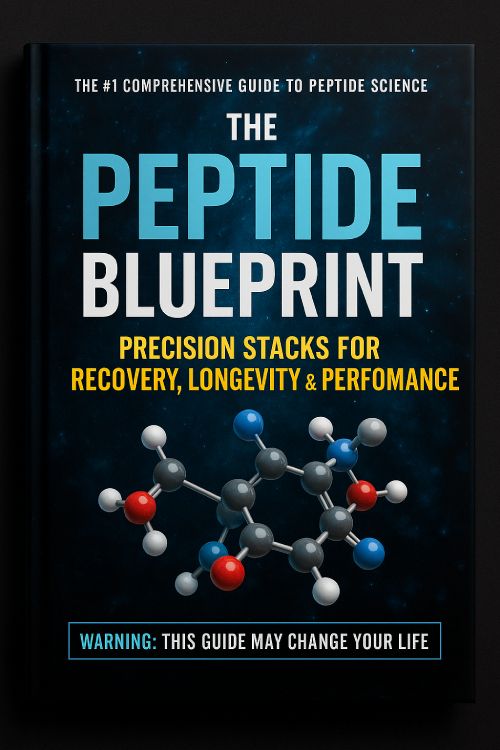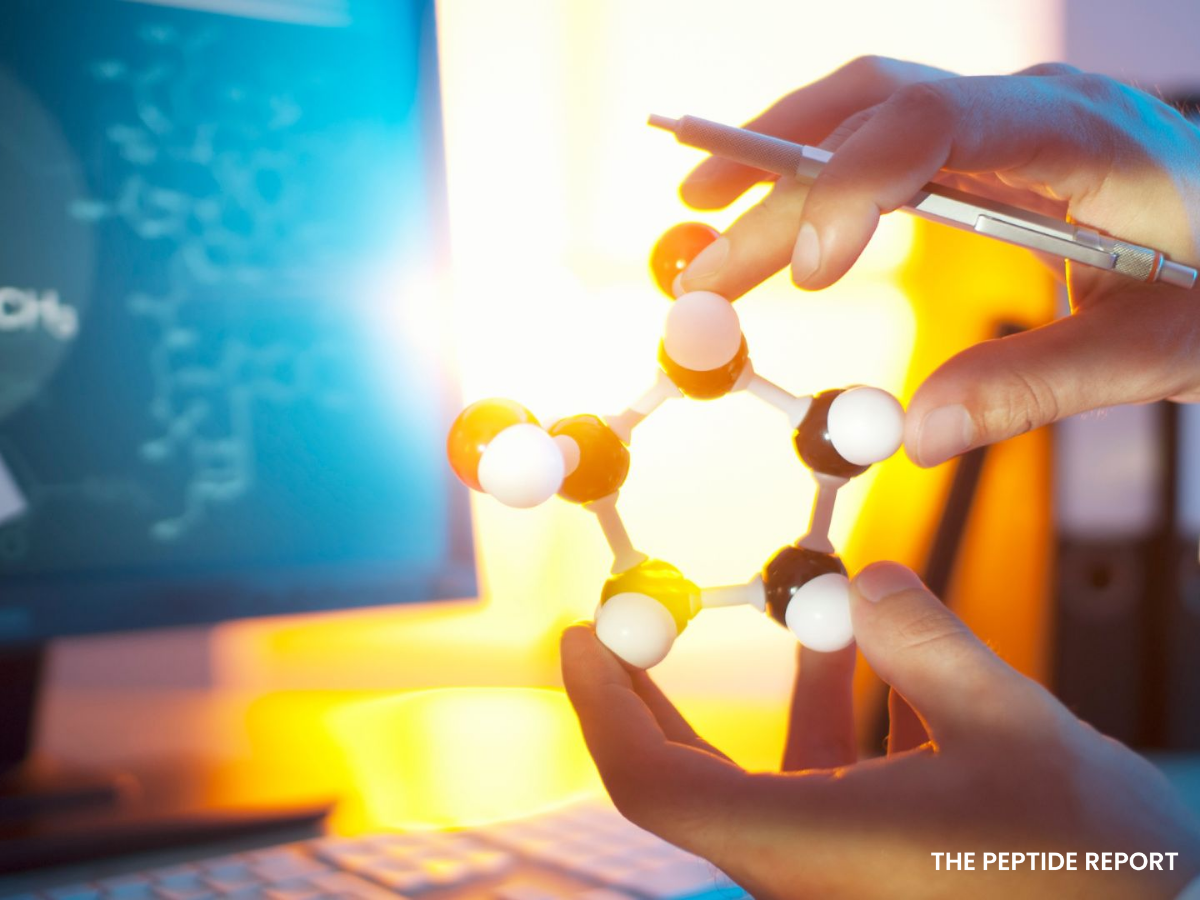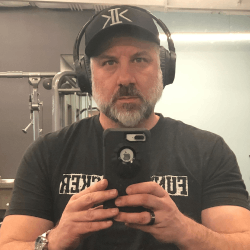Table of Contents
Are you looking to speed up recovery, reduce inflammation, and get back to peak performance faster? In this article, we’ll explore the benefits of stacking BPC-157 with TB-500—two peptides known for their powerful regenerative and healing properties.
We’ll cover how this blend may support tissue repair, athletic recovery, gut health, and more. You’ll also learn how lifestyle factors like diet, fitness, and alternative therapies can enhance results, plus practical advice on dosage, sourcing, and safety.
Whether you’re recovering from injury, optimizing wellness, or exploring advanced tools for performance, this guide will walk you through what to expect from this powerful peptide stack.
Get Your Free Copy of The Ultimate Peptide Blueprint Exact stacks, dosages & cutting-edge protocols to cut fat, build muscle, and keep results-no fluff. No spam. Unsubscribe anytime.

Introduction to BPC-157 and TB-500 Blend
The combo of BPC-157 and TB-500 is one of the most trusted peptide stacks for faster healing, reduced inflammation, and improved mobility. Originally used in research settings, these compounds have earned a cult following among athletes, biohackers, and wellness seekers for their ability to support recovery from the inside out.
BPC-157, a peptide derived from a protein in the stomach, is known for its powerful anti-inflammatory and tissue-repair properties. It’s been studied for everything from gut lining repair to ligament healing and organ protection.
TB-500 is a protein your body uses for cell migration, tissue repair, and angiogenesis (the formation of new blood vessels). That’s what makes it a standout for soft tissue recovery and even cardiovascular support.
When used together, these peptides have a synergistic effect—activating growth factors, improving circulation, and speeding up recovery from both chronic strain and acute injuries.
Understanding Diseases that BPC-157 and TB-500 can Address
When used together, BPC-157 and TB-500 may help accelerate healing, reduce inflammation, and support recovery from a variety of health issues. Here’s a closer look at what this powerful peptide combo can potentially address:
- Muscle Tears, Tendon & Ligament Injuries
Speeds up recovery from physical injuries, especially strains, sprains, and overuse issues in joints and connective tissue. - Wound Healing
Promotes faster skin and tissue regeneration, helping cuts, surgical wounds, and ulcers heal more quickly. - Gut Health Conditions
May reduce symptoms of Crohn’s disease, leaky gut, IBS, and ulcerative colitis by strengthening the intestinal lining and calming inflammation. - Arthritis & Joint Inflammation
Helps reduce joint pain and stiffness by lowering inflammation and encouraging joint tissue repair. - Cardiovascular Support
TB-500 supports blood vessel growth and circulation, which may aid in heart recovery or improve blood flow in areas with damage or restriction. - Nerve & Brain Inflammation
BPC-157 has shown potential to protect neurons and may help with nerve regeneration and neurological healing after injury.
Exploring the Connection Between Diet, Fitness, and BPC-157 and TB-500 Blend
Peptides like BPC-157 and TB-500 work best when paired with a healthy lifestyle. Your diet, fitness routine, and recovery habits can significantly influence how well these compounds support your healing and performance goals.
Here’s how to optimize your results:
- Prioritize Protein & Collagen Support
Amino acids are the raw materials for tissue repair. Eat a protein-rich diet (think lean meats, eggs, collagen, and bone broth) to give your body what it needs to rebuild. - Anti-Inflammatory Foods Matter
Focus on whole, nutrient-dense foods—like leafy greens, berries, turmeric, and omega-3 fats—to reduce inflammation and help peptides do their job more effectively. - Train Smart, Recover Hard
Exercise triggers tissue breakdown that peptides help repair. Balance intense workouts with mobility work, stretching, and rest to avoid burnout and allow healing. - Stay Hydrated
Proper hydration helps nutrients (and peptides) circulate efficiently and supports detox and tissue repair. This also reduces side effects. - Avoid Toxins & Overtraining
Alcohol, processed foods, and chronic stress can undermine the healing response. Keep stress low and avoid pushing through injury while using peptides. - Consistency is Key
Peptides support ongoing recovery and performance—not overnight magic. Stick to a routine and track your changes.
Alternative Therapies and Their Role in Maximizing Results with BPC-157 and TB-500
Combining peptides with other healing methods can take your results to the next level. Many people find even better recovery when they stack BPC-157 and TB-500 with bodywork or regenerative therapies.
Here are a few worth considering:
- Acupuncture
Helps reduce inflammation, improve circulation, and enhance the body’s natural healing response. - Chiropractic Care
Supports joint alignment and mobility, especially when paired with soft tissue recovery peptides. - Physical Therapy & Massage
Improve blood flow, reduce scar tissue, and complement the effects of BPC-157 and TB-500 on muscle and joint repair.
Grooming Tips for Enhanced Health Benefits of BPC-157 and TB-500
If you’re using peptides for skin healing or surface wounds, good grooming helps. Clean, hydrated skin creates the best environment for recovery.
- Keep skin clean
Use a gentle, non-abrasive cleanser to reduce irritation and support healing. - Moisturize daily
Hydrated skin absorbs topical peptides better and heals faster. - Exfoliate 1–2x per week
Removes dead skin cells so peptides can penetrate more effectively. - Be consistent
A daily grooming routine helps create the best environment for skin regeneration and peptide absorption.

Parenting and the Importance of Optimal Health with BPC-157 and TB-500
Peptides like BPC-157 and TB-500 can help you bounce back from strain, injury, or exhaustion, so you can keep up with life’s demands.
Faster recovery and fewer physical setbacks can make it easier to stay active with your kids, sleep better, and simply feel more present. While they’re not a replacement for healthy habits, peptides can be a powerful tool in a long-term wellness strategy that helps you stay strong for the people who count on you.
Maximizing Pregnancy Health with BPC-157 and TB-500
Pregnancy brings major physical demands, from joint strain to inflammation and tissue stress. Some wellness circles are now exploring peptides like BPC-157 and TB-500 for their potential to support recovery, gut health, and comfort during this time.
That said, pregnancy is a complex time, and any supplement or therapy—no matter how promising—needs to be evaluated by a healthcare provider who understands your full history. With the right guidance, BPC-157 and TB-500 may offer targeted support during pregnancy or postpartum recovery.
Improving Relationships Through Better Health with BPC-157 and TB-500
When your body feels better, everything else gets easier—including your relationships. Chronic pain, fatigue, or inflammation can drain your energy and dull your ability to connect. Peptides like BPC-157 and TB-500 may help by speeding up recovery, easing discomfort, and restoring vitality.
When you feel strong and clear-headed, it’s easier to be present, communicate openly, and show up fully—in all your relationships.
Other Factors to Consider for Optimal Results with BPC-157 and TB-500
If you’re new to this stack, one of the most important things to get right is how you dose and cycle. A common starting point is 1mg per day of a combined BPC-157 and TB-500 blend, taken as a single daily injection. Most users follow this protocol for 8 weeks on, followed by 8 weeks off to give the body time to reset and maintain long-term effectiveness. We will go in-depth on dosage and protocol guidelines later in the article – you can skip ahead by clicking here.
This blend is typically administered subcutaneously using a 1ml insulin syringe (29 – 31 gauge) or a peptide pen for those who prefer a needle-free option. Whichever method you choose, it’s important to follow proper sterile technique and inject in areas with soft fatty tissue like the lower abdomen or thigh. If you have any concerns about self-administration please refer to our guide Peptide Safety 101: How to Reconstitute, Inject, and Store Peptides the Right Way.
Equally important is sourcing: make sure you’re using peptides with verified purity (99% or higher) from a trusted vendor with third-party testing and transparent labeling.
Stay Updated with the Latest Trends in BPC-157 and TB-500
Looking for the latest on dosage, delivery methods, or new research? We’ve got you covered. Our site is updated regularly with trusted, up-to-date info so you can stay ahead and get the best possible results.
Review of BPC-157 and TB-500 Blend
Now that you understand the basics of this powerful peptide combo, let’s take a closer look at each one individually—starting with BPC-157, then TB-500. We’ll break down their specific benefits, dosages, and potential side effects so you can tailor a protocol that fits best for your goals.
Understanding BPC-157: Benefits, Dosage, and Side Effects
BPC-157 is best known for its role in tissue repair, inflammation control, and gut healing. It’s gained popularity for helping speed up recovery from injuries, reduce joint pain, and support gut lining health.
Common benefits include:
- Faster healing of muscles, tendons, ligaments, and joints
- Reduced inflammation and pain
- Support for gut issues like ulcers, IBS, and leaky gut
- Possible neuroprotective and mood-stabilizing effects
Typical dosage:
Most people take 250–500 mcg per day, either subcutaneously or intramuscularly, for 4–8 weeks at a time.
Side effects:
BPC-157 is generally well-tolerated. Some users report mild side effects such as nausea, dizziness, or injection site irritation. To minimize side effects, start with a lower dose, stay well-hydrated, rotate injection sites, and avoid injecting into irritated tissue.
For more information read our full article, BPC-157: How it Works, Benefits, Dosage, Side Effects and Safety
Exploring TB-500: Benefits, Dosage, and Side Effects
TB-500 is known for its role in tissue regeneration, cell migration, and blood vessel growth. It’s often used to support healing in muscles, tendons, and joints—especially when recovery is slow or mobility is limited.
Common benefits include:
- Faster healing of soft tissue injuries
- Improved flexibility and mobility
- Enhanced blood flow and circulation
- Support for joint recovery and chronic inflammation
Typical dosage:
Most people take 250 – 500 mcg once a day, via subcutaneous injection. A typical cycle lasts 4 to 8 weeks, often stacked with BPC-157 for enhanced effect.
Side effects:
TB-500 is generally well-tolerated, but some users experience fatigue, headache, or redness at the injection site. To reduce side effects, rotate injection areas, avoid injecting too quickly, and don’t exceed recommended doses without supervision.
For more information, read our full article, TB-500: How it Works, Benefits, Dosage, Side Effects and Safety
How Do BPC-157 and TB-500 Work Together for Enhanced Results?
When stacked, BPC-157 and TB-500 complement each other to accelerate healing and recovery across multiple systems. BPC-157 targets inflammation, protects tissue, and promotes gut and vascular healing, while TB-500 enhances cell movement, blood flow, and regeneration in muscles, tendons, and joints.
Together, they may:
- Stimulate growth factors like VEGF and IGF-1
- Speed up collagen production and tissue remodeling
- Reduce inflammation while supporting long-term regeneration
- Improve flexibility, mobility, and resistance to re-injury
This synergy makes the combo especially popular among athletes, active individuals, and anyone recovering from surgery or chronic pain.
Benefits of Using BPC-157 and TB-500 Blend
Stacking BPC-157 with TB-500 offers broader and faster results than using either peptide alone. While BPC-157 focuses on reducing inflammation, protecting tissue, and aiding gut repair, TB-500 boosts cell movement, blood flow, and regeneration—especially in areas with poor circulation.
Together, they:
- Accelerate healing from multiple angles
- Promote both local and systemic recovery
- Help rebuild tissue while reducing pain and inflammation
- Cover more ground: gut, joints, muscles, nerves, and more
Achieving Optimal Results with BPC-157 and TB-500: What to Expect
If you’re consistent with your dosing, most users begin noticing effects within 1–2 weeks—including reduced pain, faster recovery, and improved mobility. Gut-related improvements may take longer, often becoming more noticeable by week 3 or 4. Full results typically build over the course of a 4–8 week cycle.
Use a daily subcutaneous dose of 250–500 mcg of BPC-157 and 250–500 mcg of TB-500, delivered with a 1ml insulin syringe or peptide pen. We recommend sourcing from BioEdge Research Labs—a trusted supplier that offers exclusively third-party tested, >99% pure peptides manufactured in cGMP-certified facilities. Their TB-500 + BPC-157 combination vial contains both peptides in a 1:1 ratio making dosage simple and precise.
Here’s how to adjust your protocol based on your goals:
Injury Recovery (Muscle, Tendon, Ligament)
- Dose: 250–500 mcg of each peptide, once daily
- Injection site: Near the injury if possible
- Cycle: 4–6 weeks for acute injuries; up to 8 weeks for chronic recovery
Joint Pain & Inflammation
- Dose: 300–500 mcg of each peptide daily
- Injection site: Rotate between sites near affected joints or lower abdomen
- Cycle: 6–8 weeks
Gut Health & Systemic Inflammation
- Dose: 250–400 mcg of each peptide daily
- Injection site: Subcutaneous abdominal fat is ideal
- Cycle: 4–6 weeks
Full-Body Recovery & Performance Support
- Dose: 500 mcg of each peptide per day
- Injection site: Rotate daily for even absorption (abdomen, thigh, upper glute)
- Cycle: 6–8 weeks on, followed by 6–8 weeks off
Reconstitution & Delivery Tips for BPC-157 + TB-500
To prepare your peptides, reconstitute your 10mg vial (blended or separate) with 2mL of reconstitution solution aka bacteriostatic water. Add the water slowly down the side of the vial—don’t shake. Once mixed, store in the fridge and use within 6–8 weeks.
For daily dosing, you can use a 1ml insulin syringe or a peptide pen. If you’re using a pen, make sure it can deliver at least 0.1 mL per dose—some pens only deliver 0.05 mL per click, so confirm your model’s capacity before purchasing.
Daily Dose Volume Reference:
- For 250 mcg, draw or dial to 0.05 mL (5 units on an insulin syringe)
- For 500 mcg, draw or dial to 0.1 mL (10 units)
*If you want to see how that math works – here it is. Based on reconstituting 10mg into 2mL you get 10,000 mcg of peptide per 2mL which equals 5,000 mcg per 1mL. So a 500 mcg dose divided by this 5,000mcg in the 1mL of solution equals 0.1 mL; or for a 250 mcg dose ÷ 5,000 = 0.05 mL.
These doses apply whether you’re using a blended vial, or drawing equal parts from separate vials into one syringe.
If you are new to peptide therapy we recommend reading Peptide Safety 101: How to Reconstitute, Inject, and Store Peptides the Right Way
Side Effects
Side effects are rare, but may include fatigue, headache, mild nausea, or temporary redness at the injection site. These are often dose-related or technique-related. If side effects occur:
- Try reducing your dose to the lower end of the range (e.g., 250 mcg each)
- Rotate injection sites to prevent irritation
- Stay well-hydrated and avoid injecting into inflamed or sore areas
Most minor effects resolve quickly with small adjustments.
Ready to Put This Stack to Work?
If you want a simple, reliable way to get started, BioEdge Research Labs makes it easy with their BPC-157 + TB-500 blend—so you can dose accurately, stay consistent, and focus on recovery. With third-party tested purity, clear labeling, and a reputation for quality, BioEdge is the go-to source for researchers who don’t want to gamble on what’s in the vial. When you’re serious about healing faster and performing better, start with a supplier you can trust—grab your blend from BioEdge Research Labs and take the next step toward feeling your best.
Frequently Asked Questions
Summary of Benefits, Dosage, and Side Effects of BPC-157 and TB-500 Blend
The BPC-157 and TB-500 blend offers powerful support for injury recovery, inflammation, gut repair, and full-body performance. Most users take 250–500 mcg of each peptide daily, using a subcutaneous injection or peptide pen, and follow a standard 8 weeks on / 8 weeks off cycle to avoid tolerance.
Side effects are rare but may include temporary fatigue, redness at the injection site, or mild nausea. Tracking your response, staying hydrated, and adjusting dosage as needed is the best way to optimize results.
Used correctly, this peptide stack can help you feel better, heal faster, and stay active—whether you’re bouncing back from injury, managing stress, or just pushing for peak wellness.
P.S. — Join Our Exclusive Skool Group for real stories, sleep protocols, and community support.
References for Further Reading
TB-500 Tendon Healing and Fibroblast Migration
- Lee, J.Y., et al. (2013). Thymosin Beta 4 enhances the healing of medial collateral ligament in rat. Am J Sports Med, 41(7), 1440–1447. https://pubmed.ncbi.nlm.nih.gov/23523891
- Philp, D., et al. (2010). Thymosin Beta 4 enhances repair by organizing connective tissue in skin wound healing. J Invest Dermatol, 130(1), 287–294. https://pubmed.ncbi.nlm.nih.gov/20536458
TB-500 Inflammation Modulation
- Li, J., et al. (2018). Thymosin Beta 4 prevents oxidative stress, inflammation, and fibrosis in ethanol- and LPS-induced liver injury. Oxid Med Cell Longev, 2018, Article ID 9637560. https://www.ncbi.nlm.nih.gov/pmc/articles/PMC6079392
- Sosne, G., et al. (2018). Thymosin Beta 4 limits inflammation through autophagy. Curr Pharm Des, 24(30), 3540–3547. https://pubmed.ncbi.nlm.nih.gov/30063848
TB-500 in Gut Health and GI Repair
- Tomaselli, G., et al(2011). Immunoreactivity of Thymosin Beta 4 in human gastrointestinal tract. Eur J Histochem, 55(3), e29. https://www.ncbi.nlm.nih.gov/pmc/articles/PMC3167329
- Goldstein, A.L., et al. (2012). Thymosin Beta 4: A multifunctional regenerative peptide. Expert Opin Biol Ther, 12(1), 37–51. https://pubmed.ncbi.nlm.nih.gov/22074294
BPC-157 Wound Healing and Granulation Tissue Formation
- Sikiric, P., Seiwerth, S., & Staresinic, M. (1993). The effect of BPC 157 on granulation tissue formation, angiogenesis, and collagen production in rat skin wounds. Journal of Physiology and Pharmacology, 44(4), 413–421. https://pubmed.ncbi.nlm.nih.gov/9403790/
- Zoric, Z., et al. (2015). Body protective compound-157 enhances alkali-burn wound healing in vivo and promotes proliferation, migration, and angiogenesis in vitro. Journal of Surgical Research, 194(2), 469–477. https://doi.org/10.1016/j.jss.2014.10.015
BPC-157 Inflammation Modulation and Anti-inflammatory Effects
- Krivic, A., Anic, T., Seiwerth, S., Huljev, D., & Sikiric, P. (2006). Stable gastric pentadecapeptide BPC 157 promotes tendon-to-bone healing and opposes corticosteroid aggravation. Journal of Orthopaedic Research, 24(5), 982–989. https://doi.org/10.1002/jor.20096
BPC-157 Tissue Regeneration in Muscle and Bone Healing
- Gwyer, D., Wragg, N. M., & Wilson, S. L. (2019). Gastric pentadecapeptide BPC 157 and its role in accelerating musculoskeletal soft tissue healing. Cell and Tissue Research, 377(2), 153–159. https://doi.org/10.1007/s00441-019-03016-8

I’m Joe Mars, and I’ve dedicated the past ten years to understanding peptide therapy, longevity, and how to optimize the body through practical, real-life testing. My journey started when I was tired, inflamed, and aging faster than I should have been. Clear information on peptides was almost impossible to find, so I dug in, researched nonstop, and tested protocols on myself.
Over the years, I have learned from experts like Jay Campbell, Dr. Seeds, Jim LaValle, and Ben Greenfield, and I have completely transformed my health. Now in my fifties, I feel stronger and sharper than I did in my twenties. That experience is why I write. I want to give people simple and honest guidance so they can use peptides safely and effectively.
I believe in data, smart protocols, and taking responsibility for your own health. You are the protocol. Your habits, your consistency, and your awareness shape your results. Through The Peptide Report, I share what actually works so you can make informed decisions and build a healthier, more resilient body.

